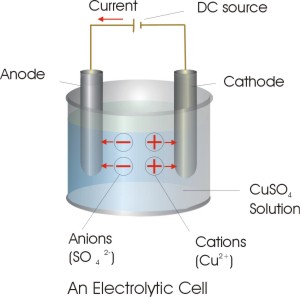It is the process of decomposition of an electrolyte by the passage of electricity through its aqueous solution or molten state.
Mechanism of electrolysis
When ever an electrolyte is dissolved in water or taken in the molten state it dissociates into positive and negative ions. The positive ions are known as cations and the negative ions are known as anions.
On passing electric current through the electrolyte cations move towards the cathode and anions move towards the anode.
On reaching their respective electrodes these ions loose their charge. On loosing their charge they get deposited on the electrode or discharged as a gas.
Let us take an example of electrolysis of aqueous copper sulphate solution using inert electrodes such as platinum electrodes.
In the aqueous solution copper sulphate dissociates into its respective ions.
CuSO4 ![]() Cu2+ + SO4 2-
Cu2+ + SO4 2-

On passing electric current the copper ions(cations) move towards the cathode and get deposited as copper. Simultaneously the sulphate ions(anions) move towards the anode.